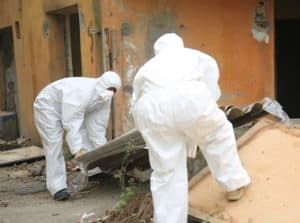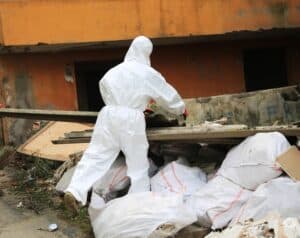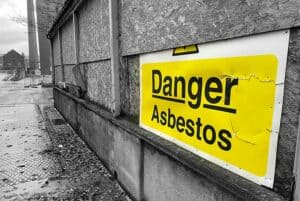Heating Systems and Boilers Asbestos Removal by Bristol Based A4 Asbestos
Asbestos was commonly used in boilers until it was banned from use in boiler manufacture in 1984.
Several pre-1984 boiler models have lasted long enough for examples still to be in use today. The problem with these boilers is friable asbestos seals (on combustion chamber covers for example). These seals are fragile and disintegrate when disturbed, shedding asbestos fibres into the atmosphere, a serious health risk to any technician working on that boiler.
As well as the actual boilers, asbestos was a common material used in lagging the pipes, within the boiler room or airing cupboard. Asbestos sheets were a very, very common material used in the room that housed boilers and heating systems. This means that even if your boiler has been replaced in the last 30 years, it is possible that the whole system, or the room the boiler is housed in, still contains asbestos.
More and more plumbers and heating engineers are becoming aware of asbestos. Sensibly, less and less are willing to work on such systems or within areas that contain asbestos.
Why is there asbestos in my heating system
Asbestos is known for its heat resistance and insulation properties and so was used to help insulate pipes, boilers, ducts and tanks in both homes and commercial properties from the 1940’s through to the 1970’s.
Chrysolite was the most common form of asbestos due to its flexibility and ability to be used as a joint compound in plaster mix known as lagging, this was used to cover and insulate pipes and boilers.
The video below is a classic example of 1940’s advertising showing the benefits of using asbestos in your home.
Boilers and pipes were the most common places to find asbestos lagging, this kept the water hot during extraction to various places within the home.
Nowadays an array of insulation such as high quality, flexible Polyethylene Pipe Insulation is used to contain heat within pipes and boilers. The European Agency for Safety and Health at Work outlined the most common forms of asbestos use and possible exposure risks at work.
Bulk:
- Asbestos laggings and packing for heat insulation of boilers, pipes, electrical ducts, electrical, water heaters, fire doors and partitions, industrial equipment;
- Sprayed asbestos on steel structures or on concrete slab soffits for building fire protection and noise insulation.
Sheets or boards:
- Asbestos millboard and paper for heat insulation (chimneys, ovens, gas or electric convector heaters, etc.), jointing and surface thermal protection;
- Boards for false ceilings or fire retardant facings, fire doors or dampers, light partitions.
Yarns or fabrics:
- Yarn, cord or rope, caulking and lagging material (lagging of boiler doors, heating pipework, engine exhausts, etc.);
- Fabric band for heat protection;
- Electrical insulating tape (electrical appliances and ductwork);
- Fire resistant, noise insulation or expansion joint seals on structures or in partitions.
Asbestos in “Warm Air Heating” Systems
Warm air heating systems, where air is circulated around the property through ducts, rather than heating radiators, are an excellent alternative heating system to the traditional boiler and radiator system. These systems were hugely popular in the 1970’ and 1980’s, and many homes of that era would have, what some would consider, a more efficient and flexible heating system. In commercial buildings, these types of systems have been used since the 1940’s. To make the system as efficient as possible, asbestos was used in the ducts. If in good condition, the asbestos does not pose a threat. However, if the asbestos is damaged or frayed then particles are blowing around your house. If any work needs to be carried out on the ducts, then the asbestos becomes an issue.
I have asbestos in my heating system – what should I do?
If a plumber or heating engineer has identified that you have asbestos present in your boiler, heating pipes, airing cupboard or boiler room they will advise it is removed. Simply replacing an old boiler will not necessarily resolve the issue.
The best advice is to get a professional asbestos company, such as A4 Asbestos, to identify and remove all the asbestos from your heating system.
Based in Bristol, and covering the whole South West, A4 Asbestos are experts in testing, sampling, removal and collection of asbestos materials from domestic, commercial and industrial premises. We have many year’s experience in removing asbestos from heating systems. For more information please telephone head office on 0117 259 1425



